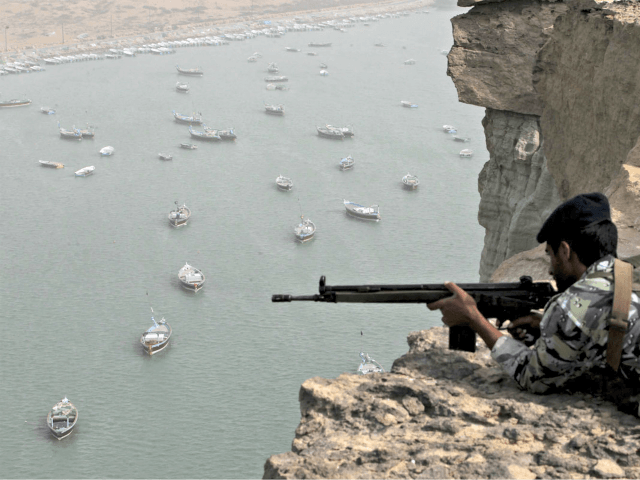Iran’s navy forces have harassed their U.S. counterparts in the Strait of Hormuz in three unsafe and unprofessional interactions this year, Breitbart News has learned.
The incidents occurred just days before Donald Trump assumed the office of the presidency.
In two previously unreported incidents, an Islamic Revolutionary Guard Corps Navy speedboat harassed U.S. ships transiting through international waters in the Strait of Hormuz during the late night/early morning of Jan. 15-16, according to U.S. Naval Central Command (NAVCENT).
On Jan. 15, the Iranian craft, a 55-meter High Aspect Ratio Twin Hull (HARTH) vessel, approached the U.S. Army logistics support vessel USAV SP4 James A. Loux and a coalition ship, crossing the bows of both vessels.
The Iranian vessel came within 500 yards of the Loux, and 2,000 yards of the coalition vessel. After crossing the bows of the ships, the Iranian boat flashed a floodlight at both ships.
The coalition vessel hailed the Iranians and requested they stop illuminating the ships. The Iranians did not respond to radio calls, but stopped illuminating the ships and left.
“Naval Forces Central Command assesses these interactions as unsafe and unprofessional due to the IRGCN’s vessel’s floodlight illumination, the close approach to the ships and failure to respond to radio calls,” NAVCENT said in an email to Breitbart News.
“Illuminating ships at night is dangerous as it creates a navigational hazard that impairs the night vision of operators,” it said.
The next day, an Iranian HARTH vessel harassed several U.S ships that were transiting the Strait at night: the USS Makin Island, an amphibious assault ship, USS Port Royal, a guided-missile cruiser, and the USNS Patuxent, a replenishment oiler.
The IRGCN vessel illuminated the Makin Island and Port Royal, including a SH-60 Seahawk helicopter in the air during the transit.
The Makin Island issued multiple radio and visual warnings to cease the illumination but received no response, NAVCENT said. The SH-60 “employed measures” that resulted in the Iranian boat altering its course and eventually proceeding outbound, NAVCENT said.
The incidents occurred just a week after four Iranian speedboats had harassed the U.S. destroyer USS Mahan, near the Strait of Hormuz, on Jan. 9 — also deemed an unsafe and unprofessional interaction.
One of the speedboats had sped towards the Mahan, with its guns manned and pointed at the destroyer, coming within 900 yards. The speedboat had ignored multiple warnings, until the Mahan fired three warning shots near the Iranian boat with its .50 caliber guns.
As of Feb. 1, there had been eight total interactions with Iranian navy forces, with three of those unsafe and unprofessional.
There have been no known incidents in the Arabian Gulf or the Strait of Hormuz since Trump took office on Jan. 20.
At a rally in September, Trump had threatened to blow Iranian ships “out of the water” if they continued to harass U.S. ships.
There is increasing concern within the Navy, however, that Iran may use proxies to increasingly harass U.S. ships in the Red Sea.
On Jan. 30, Iran-backed Houthi rebels in small boats attacked a frigate belonging to Saudi Arabia, a U.S. ally. The U.S. sent the USS Cole, a destroyer, to aid the Saudi ship a few days later in response.
A defense official told Breitbart News the U.S. Navy is planning to have a larger presence in the Red Sea, in order to keep the Bab al-Mandab Strait open for global commerce.
The plan is not in response to that incident, but rather, a string of events in the region, the official said.

COMMENTS
Please let us know if you're having issues with commenting.